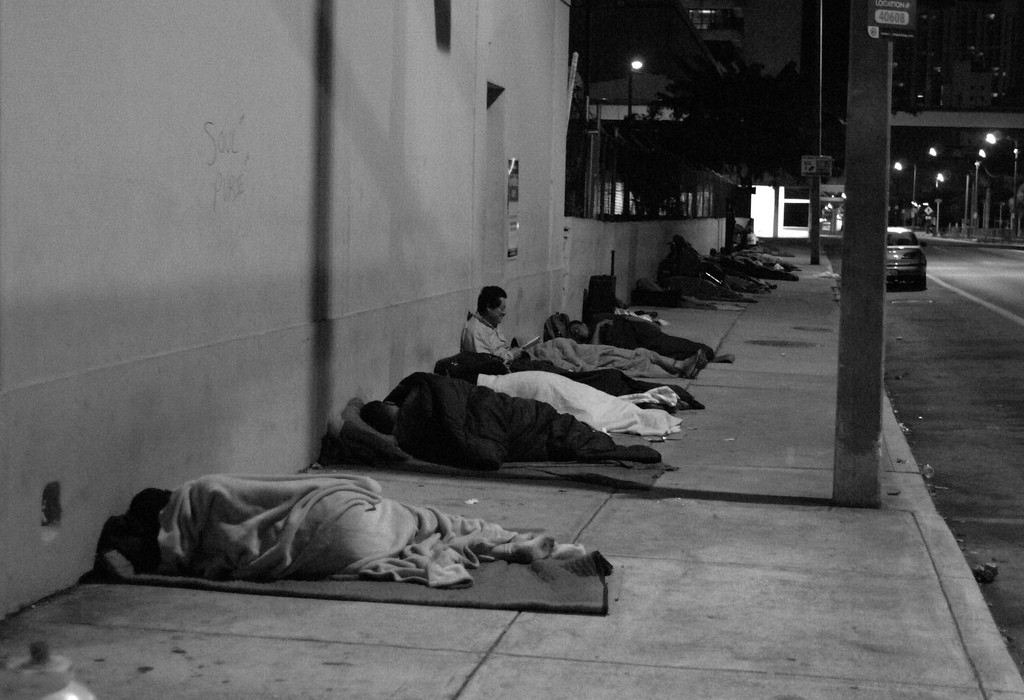

Davis is looking to offer things like permanent supportive housing at places like Paul’s Place. As the proposal notes, “DCMH staff will offer each resident on-site supportive services, which includes intensive case management.” The program staff already successfully manages the 52-unit Cesar Chavez project.
But there seems to be a misconception about the nature of the homeless problem. There are those who argue that “homeless people ended up unsheltered because of mental illness” and addiction. These facts are then used to oppose building permanent housing programs, arguing that unless we address these root causes first, we are not going to get to the origin of the problem.
That view, however, may be limited. As Paul Thornton wrote in the LA Times this weekend, “most individuals who experience homelessness don’t end up that way because of mental health issues or addiction.”
He argued that in LA County, which has a huge homeless population of 59,000, the crisis “is truly the product of California’s housing crisis, where wages have failed to keep up with rents rising ever higher because of inadequate supply.”
The LA Times editorial board counters that the percentage of people who suffer from mental illness was only one-third of those homeless. That means, of those people who were homeless at some point last year, “two-thirds were not dealing with serious mental health problems or addiction problems, but fell into homelessness because of the widening gap between wages and housing costs.”
They point out that “substance abusers and the mentally ill are the most visible face of homelessness because their behavior draws the most attention. And mental illness is more prevalent among people living on the street — and in public view — than among their homeless counterparts who are couch-surfing or living in cars or shelters.”
While those figures were specific to Los Angeles, it turns out overall the homeless population looks pretty similar. A study from 2009 found about “20 to 25% of the homeless population in the United States suffers from some form of severe mental illness.” That number seems to have remained fairly constant, with most estimates putting the number between one-quarter and a third nationally.
If that is the case, providing shelter and support services may be an avenue to deal with some of the homeless populations.
In an editorial from October 2, the LA Times argued: “Of the roughly 134,000  homeless people on the streets of California, about a third are seriously mentally ill. Their illnesses cannot be successfully treated on sidewalks. They must get housing first.”
homeless people on the streets of California, about a third are seriously mentally ill. Their illnesses cannot be successfully treated on sidewalks. They must get housing first.”
With the case of Paul’s Place, Bill Pride told the Vanguard the current building is serving about 35 to 70 people a day with the resource center, but often people are having to wait hours to use the shower or wash their clothes.
“We have 20 people signing up for showers every morning,” he said. “They have to wait an hour, sometimes two, to take a show before it’s their turn.”
In addition, the new facility would allow people to have private sleeping quarters rather than having adults living on bunk beds, which is far from ideal.
“Currently it has 12 beds – eight for men, four for women,” Bill Pride explained. The new program will reduce the number of beds from 12 to 10. “The big change for me is that right now we have three bedrooms housing four people (each), so there are four people per bedroom, all living in bunk beds.
“That’s not an ideal situation, mostly folks are adults… up to 65 years of age,” he explained. “The new building is going to have 10 transitional housing rooms but they are all going to be individual rooms for everybody.”
Finally, they are adding 18 tiny housing units – 300 square feet.
The opponents focused on “Housing First principles” and ignored that “DCMH staff will offer each resident on-site supportive services, which includes intensive case management.”
Bill Pride explained there will be supportive housing beds operated “the way we do at Cesar Chavez.
“There is going to be staff on site to help folks, give them any kind of assistance they may need,” he said. “We’re here to help the folks that move in, stay housed. That may mean dealing with some kind of crisis situation.”
The question I keep asking is this: right now those people are living on the street. Many of the programs work in conjunction with wrap-around services anyway. Isn’t it better for those people who do need treatment to not have to worry about housing while they get their treatment?
The key commitment of Paul’s Place is to find a way for those who get housed, to stay housed. Isn’t that what we want?
—David M. Greenwald reporting







I often wonder if homelessness is more “pandemic”, than “epidemic”… just like child abuse has been around, like, forever… but as the media, government, etc. , focus on and report it, instead of turning a blind eye, it is magnified…
Magnification is good, as to identifying, hopefully dealing with problems… as a %-age of the total population, I strongly suspect “there is nothing new under the sun”, it’s just that it is now being investigated/identified, talked about, discussed…
I strongly suspect that child abuse, homelessness, poverty, etc., by %-age of those affected, is not much greater (and may be less, in %-age) than it was 20, 50, 75, 100, 200, etc. years ago. But those factors are better documented, better disseminated… now that it is ‘out in the open’, we should address and deal with issues long ignored…
As Pogo (Walt Kelly) opined, “we have met the enemy…”
How in GOD’s NAME did the word ONLY slip into that sentence. 1/3 of homeless being mentally ill is a massive number. I HATE journalists who use manipulative terms like ‘only’. What’s wrong with just saying 1/3? I’ll tell you what . . . it doesn’t fit the agenda.
Yes it does. So do their heaps of collected garbage.
And of course I totally support services to help the above get back on their feet.
So if the above is the group Paul’s Place is trying to help, why the obsession with WET housing? If a person without serious substance abuse wants to have a beer at Paul’s Place or smoke a joint in their room, I couldn’t give a damn. If an opioid-addicted, bike-stealing, garbage-piling-up bum gets a dry (as in ‘out-of-the-rain’) place to shoot up because ‘Housing First’ —-> NO!
What is WET housing and what exactly is the obsession that you state?
Alan – What is WET housing?
Wet – can use drugs/alcohol as a substance abuser on admittance
In general, it probably depends upon location, cost, and long-term effectiveness for individuals facing a variety of issues. With consequences for those who cannot or will not seek treatment.
Existing neighborhoods are probably not the best place to officially permit behaviors which aren’t legal or allowed for anyone else.
There’s an existing facility in that existing neighborhood.
Yes – Paul’s Place, right?
Is it creating problems, now? Does it allow illegal substance abuse? Is it expanding?
I have not formed an opinion regarding this specific entity. My comments were more general, in nature.
I’ve not heard of a single problem at the existing facility. Bill Pride told me that he met with neighbors and they had no objections.
(“Legal” substance abuse can also be an issue, impacting others.)
Just noticed that you didn’t respond to my questions. But, if there’s no objections from neighbors, then maybe there’s no problems so far.
It seems that wasn’t the case, with Pacifico.
Let me be very clear: I support everything going down as described with Paul’s Place, except allowing addicts to use while they are there. Active addicts are by the nature of addiction self-centered takers. Help those who want to help themselves, who can grab on to a lifeline thrown their way. Those stealing bikes and laptops and using and piling up garbage should be treated like the criminals that they are. For some reason society has got so twisted that we are on the verge of forgiving these crimes. Insanity.
As the quote often attributed to Einstein goes, insanity is repeating the same action over and over again and expecting a different result. The question should be what is the more effective way of addressing the issues you raise—by denying housing and continually cycling people through the criminal justice system, or by providing housing that offers intensive wraparound services and supports? Repeatedly relying solely on demonstrably ineffective approaches meets the definition of insanity.
All approaches to addiction usually fail. Addiction is frequently terminal.
100% of the approaches you don’t try fail.
deep.
Just noting that defeatism never solved anything.
“All approaches to addiction usually fail. ”
This truism is bullspit. Many times the first rehab program doesn’t work for the client. More often the second try is successful, but if the client is determined and sticks to it, the third program seems to have a very good chance of succeeding. Whether dealing with mental illness, substance abuse OR ANY OTHER DISEASE EVERYONE HAS A BETTER CHANCE TO SUCCEED IF THEY ARE HOUSED!
Wrong.
John… amen…
Addiction is a beast that is difficult to comprehend. Not trying often ends in the death of the addict. Trying often ends in the death of the addict, and may even speed up the process.
This is not like building an ARC, Noah.
What makes you think it the responsibility of you or society to solve someone else’s addiction problem, or that trying to do so won’t itself hasten their death?
Very interesting question, many levels… part of it is practical, demonstrative… part is philosophical… along the lines of “am I my brother’s keeper?” , and “who is my brother?”
Part is a question of someone else’s belief/moral system… where are they coming from… do they expect/demand that others have to hold their views… it is a fair, yet complex question…
Tough questions imbedded… I’m working on an answer for myself… where I “am” currently, am not ready to fully share, particularly here, or now. But, I can tell you that when I find ‘my answer’ to the question, I might try to convince others, but never would act to compel others to share my view/answer…
But I see it as a very fair question, and one that folk should ‘cogitate’ on… deeply…
” Not trying often ends in the death of the addict. Trying often ends in the death of the addict, and may even speed up the process.”
Oh gosh, you’re right Alan. Let’s just do nothing. That is the Davis way, right?
You honestly think you can cure addiction, fix people who don’t want fixing?
Substance abuse exists on a spectrum. With some drugs and some people, therapies can work. It depends on them getting to the resources and developing a willingness to participate. Motivational enhancement therapy, for example, has shown good results with alcohol and marijuana (and nicotine), but proves less effective with other drugs. Contingency management can work with harder drugs. Housing can be one of the incentives. But withholding it completely, with a premise of total abstinence as a condition of housing and access to the treatment facilities provided there, makes that impossible.
Here’s a good resource: https://www.drugabuse.gov/publications/principles-drug-addiction-treatment-research-based-guide-third-edition/preface
The road to Hell is paved with good intentions. Nowhere is this more true than in society attempting to cure substance addictions.
Yup.
Do we have enough housing for everyone who needs it? If not, why give it to those actively using?
Alan wrote,
And, not trying to differentiate between “addicts” and “users”… once sheltered, particularly publicly assisted facilities, the social contract should be ‘no use, while sheltered’… minor infractions should not end the sheltering, but a “three strikes and you’re out”, even on minor, should be considered a ‘breach of the social contract’… many places have a “one strike, then you’re out” policy… not necessarily helpful…
With nuances, I agree with Alan in his main point.
I agree, one strike policy is too strict.
The Vanguard has very strange and inconsistent conclusions in this article. One one hand the article tries to minimize the connection of homelessness to mental illness and drug/alcohol addiction. And then the article states that we need “housing first” programs because of these very issues.
A HUD study found the following: “An estimated 26% of homeless adults staying in shelters live with serious mental illness and an estimated 46% live with severe mental illness and/or substance use disorders.”
I don’t know why it it good policy to pretend this isn’t one of central factors in the issue.
I cited a reference to a comprehensive study/count by HUD and the numbers are within the general range of other studies before and since. Since the rate of severe mental illness is only about 3-6% for the general (non-homeless) population, the real question is why is the LA Times trying to minimize the importance of mental health problems—which, combined with alcohol/drug addiction, affect about 50% of the homeless population. Clearly, they need supportive services to address these problems. It is a bad policy approach to ignore this and to downplay the effects of these issues.
Too bad the LA Times Editorial Board got their facts wrong. If somewhere between 1/4 to 1/3 of the homeless population has serious mental health problems and 1/4 to 1/3 have drug/alcohol addiction problems, that does not mean that 2/3 of the population does not have either like they state here: “But of the more than 100,000 people in the county who were homeless at some point last year, two-thirds were not dealing with serious mental health problems or addiction problems.”
While there is some overlap of people who have both, there are people who have just one of the maladies. And in reality, the figure is more like 50% who have one or both. And given the incidence rates for these problems that are many, many times higher than that of the general population, it is really strange for the LA Times to call this a “myth”. Policy solutions that do not recognize the significance of these problems (whether they problems are cause or effect of homelessness, or a bit of both) will not be effective.
And why would the Vanguard simultaneously push this false narrative while also calling for a facility that provides supportive services for these problems?
Sounds like the left hand doesn’t know what the left hand is doing.
In contrast with this statement from the LA Times—“…two-thirds were not dealing with serious mental health problems or addiction problems,” here’s what the National Coalition for the Homeless says about one component of this issue:
“Substance abuse is often a cause of homelessness. Addictive disorders disrupt relationships with family and friends and often cause people to lose their jobs. For people who are already struggling to pay their bills, the onset or exacerbation of an addiction may cause them to lose their housing. A 2008 survey by the United States Conference of Mayors asked 25 cities for their top three causes of homelessness. Substance abuse was the single largest cause of homelessness for single adults (reported by 68% of cities). Substance abuse was also mentioned by 12% of cities as one of the top three causes of homelessness for families. According to Didenko and Pankratz (2007), two-thirds of homeless people report that drugs and/or alcohol were a major reason for their becoming homeless.”
https://www.nationalhomeless.org/factsheets/addiction.pdf
Many (not majority, and cannot cite good statistics) of the homeless I’ve interacted with, had other issues… which led to drug/alcohol use as “self-medication” to deal with the underlying issues… low self esteem, parental and/or sexual abuse, MH issues, PTSD, [some/all may be intertwined]… never met one who sought to be an “addict” to drugs/alcohol.
Meet these folk… hear their ‘story’ (if they are sober)… then think of their ‘position’ and yours…
Just saying… there, but for the grace of circumstances, and perhaps other grace factors, go a lot of us…
I looked at the study Rik was pointing to. It was a PIT study from January 2010. It found on a given night about 26% of sheltered homeless adults had a severe mental illness and 34.7 percent had substance abuse. Those numbers appear to be in the range of the studies reported from the LA Times and other recent studies. So I’m not sure why Rik thinks that study from nearly a decade ago trumps the research cited by the LA TIMES EDITORIAL BOARD.
In terms of his last question – it seems to me one of the problems with overstating the mental health component is stigmatizing the homeless population and creating an opposition to policies like this which seek to house the unhoused.
Did you capitalize this because of their God-like status?
Craig… the fact that the PIT study was a ‘snapshot’ was a good point to raise… snapshots are what they are… not necessarily indicative of patterns, but possibly… something about a stopped clock being right twice a day…
Just saying…
If the Vanguard ever loses Alan M. as a commenter, it’s probably done. 😉
An “equal-opportunity” humorist.
One man’s “humorist” is another man’s “a**hole”.
It’s a fine (and subjective) line between the two.
Alan… yep… I’ve resembled that remark… hopefully, only occasionally…
Alan, one possible exception… Will Rogers… another might be James Thurber… but in the main, you are correct… Samuel Clemens would fit… Twain was one who you either thought humorous, or the “a” word…
I strongly like all three… much truth in their humor…
Here is another, powerful ‘alternate’ point-of-view article on so-called
“homelessness” from the City Journal, which counters the “only one third” THING:
An Addiction Crisis Disguised as a Housing Crisis – Opioids are fueling homelessness on the West Coast.
by Christopher F. Rufo
Homelessness is an addiction crisis disguised as a housing crisis. In Seattle, prosecutors and law enforcement recently estimated that the majority of the region’s homeless population is hooked on opioids, including heroin and fentanyl . . . for the unsheltered population inhabiting tents, cars, and RVs, the opioid-addiction percentages are even higher—the City of Seattle’s homeless-outreach team estimates that 80 percent of the unsheltered population has a substance-abuse disorder.
I puzzled with what the word only is all about, nor why there is such a push to minimize the perceived percentage of active addicts on the street — regardless, help those that are willing, do not prop up the bum! Or, put in more in woker words by a commenter paraphrasing “the late Bob Cote” who ran a rescue outfit called Step 13 in Denver:
You get sober and you work — “Work works”. If you give people on the street money you are helping to kill them on the installment plan. If you call Step 13 we will mail you a book of coupons for a meal and a shower and a place to live to give to those ready to turn their life around. The coupons are for handing to the street people you encounter, instead of cash. Yet in 20+ years only 2 street people have showed up with a coupon, after thousands of coupon books had been distributed. Do NOT give street people money! Give them food or water or prayers or whatever. These are broken people, and you don’t fix broken people by helping them stay broken.
City Journal is basically a right wing publication, fwiw.
Not that there’s anything wrong with that.
The Vanguard is basically a left-wing progressive blog, fwiw.
Regardless, as a non-partisan and non-wing, I am fascinated and bit puzzled by the discrepancy between 33% and 80% depending on your political affiliation or ideology. Why would right-wingers try to claim more homeless are drug addicts than actually are, and why would left-wingers try to claim less homeless are drug addicts than actually are? How can belief system alter the ‘facts’ so catastrophically, and more to the point — what is the motivation to do so, and then believe those facts and discredit the ‘other’ side? Why so on both sides? I really don’t get it.
My interest is not enabling active users, but whether that is 33% of 80% of the un-housed matters not as to policy – only that we help people who truly want help in relation to their needs. So it seems to me important that this number get a bit closer than forty-seven percentage points apart — surely we can scientifically nail it down a bit closer than that!
Well said… je d’accord…